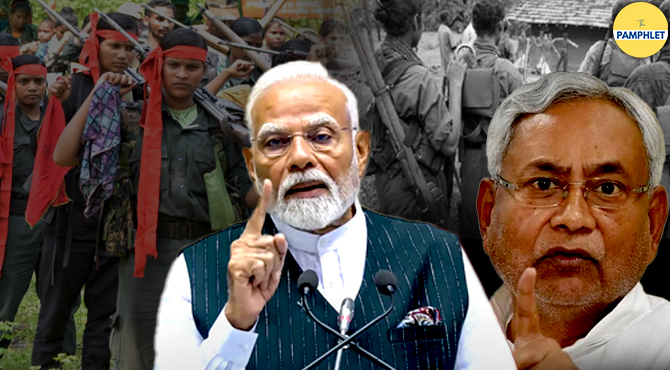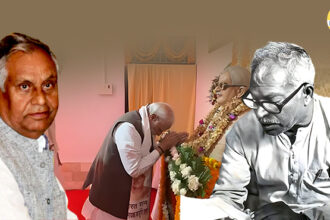It was from the soil of Bihar that PM Modi launched Operation Sindoor. While this year is significant for India’s war against terror, for making strides in defensive and precise operations launched on Pakistan’s territory, the importance of Centre’s success in launching targeted operations towards the decline in Naxalite violence, Naxal control, and Left Wing Extremism (LWE) activities, has been underlined in 53 per cent decrease in violent incidents between 2004-2014 and 2014-2014 as per government data. Security personnel deaths dropped by 73 per cent and civilian deaths by 70 per cent. Today, Bihar, one of the states affected by Maoist violence in the past, is featuring in India’s success in the combat against Naxalism.
To arrive there, Bihar under NDA has worked on reducing the governance deficit, has treated Naxalism as not solely a security problem, but also as an issue propelled by governance deficit. Bihar under NDA has taken the fight against Naxalism beyond reactive stances, and has worked on sealing vacuums on which Naxalites thrive.
Different sections of the media are reporting on the impact of “jungle raj” on Bihar for decades, and rightly so. However, taking a back seat is the fact that Bihar suffered a double blow — of LWE violence and jungle raj that set its journey backward — against the vast reserves of human and other resources and capability it never really lacked. The continuous and concentrated efforts against Maoist terror and activities in the state have given Bihar the instrument of progress, its own strengths, and the reconnection of safety and security with the lives of people in their own land.
Breakthroughs that matter to the Centre
Among breakthroughs made by the Centre in targeting Maoist violence in Bihar according to government documents are: gaining access to “extremely inaccessible areas of Chakrabandha and Bhimabandh of Bihar”, the successful ousting of Maoists from areas that became known as their strongholds, making ground for the setting up of “permanent security forces camps”, recovery of weapons, including IEDS from areas taken over. The PM Modi-led government intensified operations under a Zero Tolerance Policy against Left Wing Extremism and Terrorism between 2014 and 2025. It expedited these operations for more success. In his speeches around the Bihar Assembly election 2025, PM Modi has reiterated that the crackdown on Naxalism in Bihar has secured the future of people in Champaran, Aurangabad, Gaya, and Jamui – among the Naxal-violence affected districts in Bihar.
In response to a question in the Rajya Sabha about Naxal activities, decline and action taken by the Centre, Minister of State in the Ministry of Home Affair, Nityanand Rai informed that LWE-perpetrated violence, in Bihar, there were 48 instances in 2019, 17 in 2020, 20 in 2021, 11 in 2022, 4 in 2023 and 2 in 2024.
In the same response, it was mentioned that the Centre assists “the LWE affected States for capacity building by providing Central Armed Police battalions, training and funds for modernization of State police forces, equipment and arms, sharing of intelligence, construction of Fortified Police Stations etc. The government is contributing to development aspects, flagship schemes, improving road network and telecommunication connectivity. Work has been done on skilling and financial inclusion of people living in the Naxal-affected areas.
Notably, there is a mention of “eliminating the security vacuum from Bihar” in government documents. There is no doubt that cracking on this security vacuum was a task cut out for the central government as well as the state government. Bihar CM Nitish Kumar, who, as a state CM saw a transition – from UPA to NDA – at the centre, at different junctures, had to reiterate this message to Delhi. How Delhi received his message – varied – between the two governments, of which media reports and government documents present fair reflections. People in Bihar this author spoke with, make repeated assertions, that addressing the stifling issue of Maoist violence in Bihar became possible because the Nitish government was determined to break the control of Maoists and Maoist violence in the state in partnership with the Centre and PM Modi.
While PM Modi has criticised the previous governments for failing people, a government document mentions Bihar as one of the states “where there are several instances of exploitation of tribal communities by Naxalites”, including disclosures of sexual exploitation at Maoist camps, including “rape, forced marriage and molestation by senior male CPI (Maoist) cadres…” coming to the notice of the government.
The issue of Naxalite violence was raised by PM Modi in Gaya, during the BJP’s campaign in the 2020 assembly election. Reports remind that PM Modi warned people against voting for “them” (the RJD) and said that “Naxalism would return” if people voted them to power. He even accused the opposition parties of not only being silent on Naxalism, but also supporting it. The RJD allied with the CPI (ML) in 2020 and the latter won 12 seats, securing 3.2 per cent vote share. Reports point to the party’s clubbing with Maoist groups “by the intelligence wing of the Bihar police.” This time, the CPI(ML) is part of the INDIA bloc in Bihar, and has released its list of 20 candidates while fielding 12 sitting MLAs.
The era of Maoist darkness
Meanwhile, there is a reason why CM Nitish Kumar says that Bihar is progressing on the path of development and social balance. The reason is the social balance that the NDA government has been able to create in the state with the delivery of welfare schemes to the poor, the backward sections of the society and the poor. Pamphlet ground reports in Bihar by Prabhat Ranjan Mishra reveal several interviews with voters where they state that policies for the poor, backward and women have really reached the lowest rung of the society and that it is one of the defining factors they support the NDA in 2025.
Chanchal Kumar, a voter from Begusarai this author spoke to, said, “There are Biharis who have witnessed the days of Naxalite impact on Bihar. Today, when the younger generation goes to vote for the future of Bihar, there are people who are deciding to share awareness on Naxalite violence in Bihar – the state that also endured “jungle raj,” where “Naxal” and “Naxalite” are words associated with the past.”
Nand Raj from Purnia told this author: “I feel that the next generation will have to be told about and introduced to the word ‘Maoists’. It is not visible on the ground today, but many of us have known its impact on the ground and its presence in the narrative of Bihar.”
Even today, there are traces of Naxalism left in Lakhisarai. Special arrangements have been made to ensure free and fearless voting in the district. Deepak Singh, one of the workers representing the NDA, is on the ground to strengthen arrangements at booths of concern. “We have seen transformers being set to fire and several other expressions of violence from the Maoists in the district. Lakhisarai was reeling under Maoist violence once. Things have improved massively under the NDA government, but there are parts of the district that need more work. The era of fear is over. The era of development has to be strengthened.”
Begusarai was once known as “Purab ka Leningrad” – a phrase now often used by sections of the media for romanticising the idea of Naxalism in Begusarai – as if a badge of honour. It was the seat of political influence of the Left, and still is. Maoists were once hugely dominant. Chanchal adds. “It was darkness all around. Bihar was under the shroud of terror. There were parts of Bihar where the spell of darkness would appear even before sunset. People would shut themselves up inside homes. Women were subjected to crime. However, the tide turned after a nationalist government came to power.”
How does the being in power of a nationalist government help? “Nayi neeti ke kaaran yahan Maovadi ki sakreeyata ko bahut hadd tak kam kiya gaya. Bihar ki dharti se Maovad ka astitv samaapt ho gaya hai. Aane waali peedhi ke liye maovadi shadb parichey ka shabd nahin rahega (due to the new policies, Maoism’s influence here has been severely curtailed. Maoism has been wiped out from the soil of Bihar. The word “Maoism” will no longer be a familiar term for the next generation),” he adds.
Caste dynamics played a role in Bihar’s Naxal problem. How does Chanchal Kumar view this aspect? He adds, “It is said that Bihar and Uttar Pradesh are tangled in caste complexities. These notions are correct to some extent. However, the ground reality is different. In Begusarai, Samastipur, Darbhanga, Saharsa, the sawarnas are accused of exploiting the backward, Dalits and poor. While there are instances of feudalism in these districts, there were people with feudal attitudes in every caste who were exploiting others. This led to social imbalance. However, later, people of different sections of the society vowed to walk together.”
Naxalite activities rattled efforts of development. In one instance in 2010, reportedly, around 50 naxalites stormed into a construction site, burning equipment of a power plant which was being jointly set up by railways and NTPC in Aurangabad, Bihar. Naxalites took some of the workers hostage and assaulted them. According to Chanchal, Nitish Kumar’s coming to power initiated the shift.
He adds, “Before 2005, the industrial units in Begusarai, which is known as the karmabhoomi of Bihar’s first CM Bihar Kesri Dr Krishna Singh, were suffering. IOCL was turning into a godown. The NTPC plant suffered losses. Communist gundo ne industry ko band karaa diya thha. Sare karkhane astitva ke liye sangharsh kar rahe thhe (Communist thugs had shut down the industry. All the factories were struggling for survival). It was the will power and work of CM Nitish Kumar that began the chapter of the revival of Bihar’s industries. Today the revived industries are providing livelihoods to so many people.”
Union home minister Amit Shah recently said in one of his speeches that Bihar has become free of Naxalites and it will become the growth engine of the East. The NDA at the centre ensured continuity of its multi-pronged approach to combat the issue.
In 2018, former Union Home Secretary Rajiv Mehrishi told the press that demonetisation “had choked funding to the Naxals and they became more desperate since then.” At a BJP function in 2019, former Union Home Minister Rajnath Singh told this author that the Centre was taking focussed steps towards improvement on the ground, maintaining its zero tolerance stance towards Naxal violence, ensuring development initiatives and implementation in Naxal-affected backward areas, and modernisation of anti-Naxal forces.
The transition – from fighting it alone to NDA teamwork
The path to transition — from Naxalism in Bihar to peace and improvement — wasn’t easy for CM Nitish Kumar. One of the deadliest attacks on paramilitary forces by Maoist rebels took place in April 2010. The Maoists massacred 74 members of the Central Reserve Police Force (CRPF) and two policemen from the Chhattisgarh police in Dantewada, Chhattisgarh. A month before this deadliest attack, in March 2010, home secretary GK Pillai reportedly commented on Bihar CM Nitish Kumar. The context was Maoist violence and the way the Bihar CM was handling the issue. Pillai reportedly said that there was no hard action on Maoists in Bihar, since assembly polls were scheduled in the state later that year. Pillai was speaking at a seminar, and according to a Times of India report, he said that the Centre was not willing to intervene if Kumar felt that he would tackle LWE all by himself, but then he later should not ask for paramilitary forces.
In April, after the Dantewada massacre, Kumar spoke but spoke tough. He made it clear that he was against using any force on Naxalites in the state. In the wake of events at Dantewada, he warned the Centre against using enforcement action alone, called for an integrated approach, and warned against causing alienation. Kumar also criticised the Planning Commission’s integrated action plan towards developing Naxal-affected areas. He considered problematic an approach that would cover only 35 out of the 83 districts, leaving out 48 districts, causing them to remain backward. This, Kumar argued, would not solve the problem. It was 2010 when Kumar’s approach made news and was discussed widely in the media.
Kumar would make it clear that working on grassroots, taking care of the deprived sections of Bihar’s society to alienate them from the temptation and opportunity of serving as fighters to the guerrillas. He identified the core issue of serving the deprived classes through policy-making and policies, taking policy, government and welfare to the “dwar” (doorstep) of the deprived sections, and refused to join Delhi in the song of enforcement action. He even distanced himself from Delhi and maintained his stand of not using force on the red rebels.
Redefining ‘family’ in Bihar
Empathy brings security. Empathy fills vacuums. Empathy enables loyalty to shift base. Empathy plants a seed of reform in the local support. CM Nitish Kumar’s style of handling the Maoist issue was redefining how the deprived sections are engaged, what “talking welfare” and “talking” to them means and shapes when using force is not the only option or is ineffective in socio-political aspects of gaining ground lost to violence and winning people lost to the political dimensions of Maoism.
Kumar needed a partner at the Centre that understood his strategy and need for his strategy — in the context of Bihar, where caste and social groups and their involvement, engagement and conflicting views, contribute to complex contours of the issue.
The state issue — from Kumar’s perspective and the Centre’s understanding of Bihar’s way of configuring the issue under its own national perspective – converged under the Modi-led government in Delhi. Modernising anti-Naxal forces and strengths, re-calibrating preparedness to fight the issue on the ground, looking for a lasting solution with a multi-pronged strategy, securing measures through focussed upgradation of developmental infrastructure, ensuring the welfare of local communities, ensuring protection of their rights, routing implementation of policies towards the welfare of tribal communities, would slowly merge with Kumar’s own strategy.
In this article by this author Union Minister and senior leader of the NDA in Bihar Ram Nath Thakur mentions that it is the convergence of values such as empathy and respect for people in the work and politics of PM Modi, CM Nitish Kumar and union home minister Amit Shah, that has enabled Bihar’s progression towards social justice, development, and becoming Naxal-violence free.
Thakur draws a parallel – in two different eras and two different sets of leaders that have helped bring transformation to Bihar. He says, “Take the instance of the 1970s. During Lok Nayak Jayaprakash Narayan’s time, the biggest dacoits were in Chambal. How far would they stay away from their families and for long? How desperate were they? He heard them and he gave these people the opportunity to reform. The Chambal Valley’s problems ended, and CM Nitish Kumar, PM Modi and Amit Shah, who promised to eliminate Naxalism, are working to resolve these problems, and Naxalites are surrendering and entering the mainstream. This is a significant achievement and Bihar has watched it.”
Political will: The importance of political will to prepare an effective and gradual crackdown on Maoist violence has been the subject of PM Modi’s speeches not only on occasions meant to congratulate the massive efforts launched by the security apparatus, but also his political speeches ahead of the assembly election in Bihar. He has highlighted the improvement in lives owing to the eradication of Maoist violence in the state, alongside highlighting the improvement in lives owing to the policies, discharge of basic amenities and beneficiary programmes of poor, Dalits, backward classes and groups, and tribal communities, led by the NDA-government in Bihar and at the centre. The NDA government has underlined the “neglect” people have faced on account of misgovernance and arrogance of previous governments.
The aspect of ‘family’: There is another aspect the NDA leadership under PM Modi has clearly been able to establish in public interactions around the assembly poll in the context of law and order in the state and Naxalism. The aspect of family in relation to governance and misgovernance. The NDA government’s fight against Maoist terror, the NDA’s narrative points, rapidly led to the safety, security and improvement of lives of Bihar’s youth, Bihar’s women, men and women in the tribal communities. On the other hand, PM Modi’s speeches have relayed the message: it is misgovernance in Bihar that led to the distancing of the youth of Bihar from equal rights, as leaders who show respect to their own family members, fail to show respect for people outside their own families — a result of what he calls “arrogance in politics.”
The intermingling of the national perspective with the state perspective in how the Naxal issue has been viewed and handled, is that one strong feature in the NDA government at the Centre and the state, and their partnership, that differentiates them from previous governments. It would not be wrong to say that the difference has played a positive part in bringing change to Bihar, setting the present apart from the past. There have been moments of hard talks from both the state and centre – between each other – over the handling of the Maoist violence. But they have been able to achieve change because both had a common cause – empathy and security — for people. Ensuring security with empathy towards the people of Bihar, including those, who were being whisked away to Maoist violence. Is it not what sushasan is meant to achieve?









